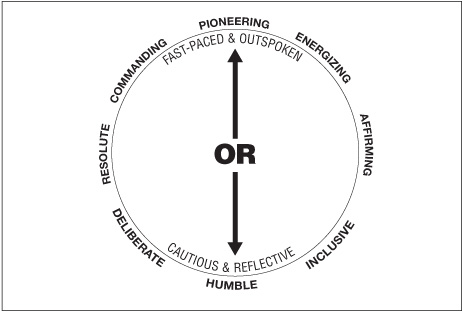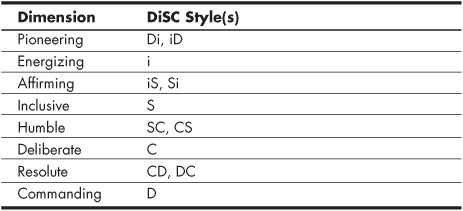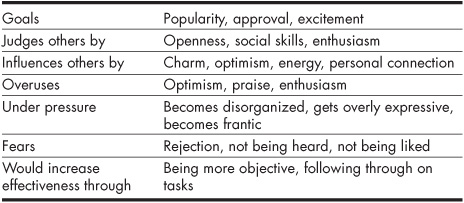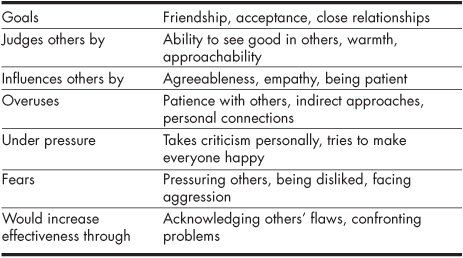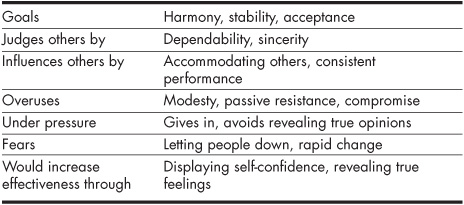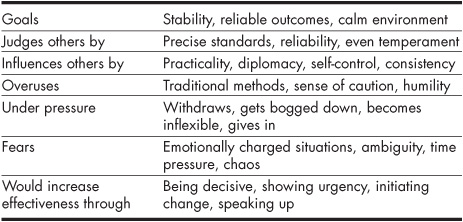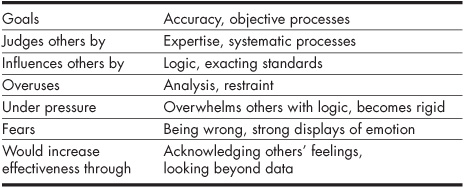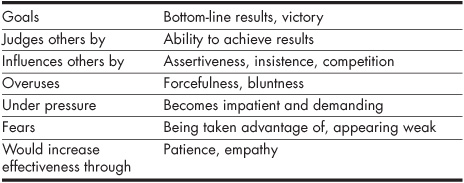Chapter 2
Discover Your Primary Leadership Dimension
Introduction
Perhaps you’re one of the millions of people around the world who have taken a DiSC® assessment through a workplace training session, or, this may be your very first encounter with this simple yet powerful model of human behavior. No matter. Whether you’ve previously “done DiSC” or not, this book can help you learn the model, discover your own style, and use the 8 Dimensions of Leadership Model to increase your effectiveness as a leader
What, exactly, is DiSC? The DiSC assessment is a tool that helps individuals assess which of several behavioral styles describes them most accurately. By learning their individual DiSC styles, people can gain a better understanding of their own strengths, challenges, fears, and motivators. More importantly, they can learn how to use DiSC to strengthen their relationships with others, building stronger, better-functioning organizations, one relationship at a time.
DiSC 101
Before we dig into the 8 Dimensions of Leadership Model further, we’ll provide an overview of the DiSC model. In its simplest form, the DiSC model includes four basic styles—D, i, S, and C. These initials stand for Dominance, Influence, Steadiness, and Conscientiousness. Within each of these four “primary” styles, there is some variation. For example, some people who fall in the D quadrant lean slightly toward the i quadrant, whereas others lean toward C. The former have the Di style—that is, D flavored with i—whereas the latter have the DC style. There is also variation in intensity of the styles. Some people are strongly inclined toward one style, while others are more of a blend of all of the styles. For more information about DiSC, please refer to the Appendix.
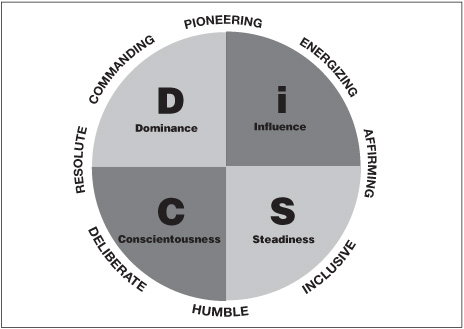
Figure 2.1. The DISC® Model
Origins of the DiSC® Model
In 1928, physiological psychologist Dr. William Moulton Marston (1893–1947) published Emotions of Normal People, a book that laid the groundwork for what would become today’s DiSC assessments. Marston was interested in theories that helped explain emotions and their physical manifestations. In Emotions of Normal People, Marston proposed that people express their emotions through four primary responses.
According to Marston, the four primary types of emotional expression are related to how a person perceives him- or herself in relation to the environment. Marston organized these self-perceptions in a two-axis model. While the original model was quite technical, it can be best understood in terms of favorability and power. The first axis shows whether a person perceives the environment as favorable or unfavorable. The second axis shows a person’s perception of his or her own power within the environment. Specifically, this axis measures whether a person views him- or herself as more or less powerful than the environment.
By weighing a person’s self-perceptions of these two axes, Marston proposed that his or her emotional state could be described using one of four DiSC behavioral styles. While Marston didn’t develop a psychological instrument to measure his theoretical model or determine one’s primary DiSC style over time, many researchers have continued to develop and refine such instruments over the past 80 years. While the labels for the four DiSC styles have changed, Marston’s original theory remains the archetype of modern DiSC instruments such as the DiSC model described here.
Placing Yourself on the 8 Dimensions of Leadership Model
Now that you understand the basics of DiSC, we’ll describe the two main axes of the 8 Dimensions of Leadership Model to give you a sense of the behaviors associated with different areas of the model. If you aren’t sure of your DiSC style, this should help you begin to identify which of the eight dimensions resonate most with you.
Two Axes of the Model
First, imagine that there is a north-south axis running down the center of the circular 8 Dimensions of Leadership Model. On one end of this axis—the northern end—are those dimensions that include more fast-paced and outspoken qualities: Commanding, Pioneering, and Energizing. Leaders who tend toward these styles prefer high-energy environments where they can act quickly and try new things. They tend to get bored with repetitive tasks, and they may grow restless when expected to work methodically for long stretches of time. Personal power is important to them, and they long to play a vital role in the organizations in which they’re involved. They often have a high need for recognition, and they may grow frustrated in environments where they don’t feel their talents are being put to good use. Leaders with these styles tend to be confident, and they’re rarely timid about sharing their opinions.
On the other end are those dimensions that include more cautious and reflective qualities: Deliberate, Humble, and Inclusive. Leaders who primarily use these dimensions prefer structured environments where they can work methodically to ensure stability. They tend to be fairly careful, and they often favor tried-and-true methods over radical innovations. Reliability is important to them, and they strive to serve their organizations responsibly and consistently. They don’t like to be in the spotlight, and they may grow frustrated in environments where people seem more concerned with getting ahead than doing a good job.
Figure 2.2. The North-South Axis
These leaders are often more reserved, so they tend to use more understated leadership behaviors.
Consider which end of the north-south axis sounds most like you. You may feel like you’re firmly planted at one end or the other, or you may be less sure. When it comes to your default behaviors, it’s possible to fall anywhere along the axis, from the edge of the circular model to the center.
Next, picture a second axis—a west-east axis running across the middle of the model. On the western side of the axis, you’ll find those dimensions that feature more skeptical and questioning tendencies: Deliberate, Resolute, and Commanding. Leaders who primarily use these dimensions naturally ask a lot of questions. In fact, they often approach new ideas—and new people—with skepticism. They like to solve problems, and they may even be energized by the challenge of overcoming an unexpected obstacle. Competency is important to them, and they want to be seen as capable of working independently to deliver on their promises. They often have a high need to be right, and they may become argumentative when others call their logic into question. Leaders who primarily use these dimensions usually try to be objective, and they don’t like to let emotions play a part in their decisions.
On the eastern side of this axis, you’ll find those dimensions that feature more warm and accepting behaviors: Energizing, Affirming, and Inclusive. Leaders who primarily use these dimensions want to create friendly environments where people and ideas are respected. They want everyone to get along, and they may struggle to handle conflict. Because collaboration is important to them, they strive to make other people feel like important members of their team. They often reach out to others with praise and encouragement, and they may dislike working closely with people who they see as critical. Leaders who primarily use these dimensions are accepting, and they tend to focus on the positive qualities of other people and ideas. Reflect on which end of this axis sounds most like you.
Most likely, you’ve been able to identify approximately where you fall on each of the two axes. Keep in mind that concepts located across from each other on the circular model are theoretically opposed. Therefore, most people tend to gravitate toward one end of each axis, though some are, indeed, in the middle. While you no doubt exhibit qualities of all eight of the dimensions from time to time, one area of the circular model is likely your emotional stronghold—the set of consistent leadership behaviors that you rely on by default. Take a moment to select the area of the model that sounds most like you. For example, if you suspect that you’re most comfortable in the southeastern corner of the model, chances are good that your primary dimension is the Inclusive Dimension, but you’ll want to look carefully at Affirming and Humble as well.
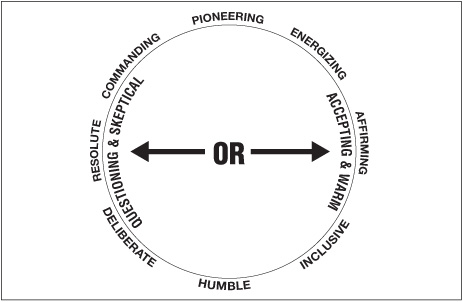
Figure 2.3. The West-East Axis
Self-Assessment Options
You have three self-assessment options to identify your primary leadership dimesion:
1) Online assessment,
2) Previous DiSC assessment, or
3) Estimation based on written descriptions.
If you received an e-mail with a personalized access code from a consultant, click on the link to take your assessment. If not, you can use the online assessment at www.8DimensionsOfLeadership.com to identify your primary leadership dimension more accurately. If you already know your DiSC style from a previous assessment, you can line it up with the corresponding leadership dimension, as shown in Table 2.1. If you don’t know your DiSC style and prefer not to use the online assessment, the rest of this chapter provides descriptions to help you to estimate your primary leadership dimension by gaining a better understanding of each dimension. As we travel around the circular model, you’ll be able to home in on which of the eight leadership dimensions sounds most like you.
Table 2.1. DiSC Styles and the 8 Dimensions of Leadership
The Pioneering Dimension
Leaders who primarily use the Pioneering Dimension tend to be adventurous, dynamic, and charismatic. Their optimistic and persuasive style often inspires others to join their efforts, and because they’re good at making connections, they’re often able to leverage relationships to help reach their ambitious goals. They tend to be extremely action-oriented, and they may be impulsive at times. Because they want to make exciting breakthroughs, they’re naturally drawn to new opportunities, and they may sometimes move ahead without considering how their decisions could affect others.
Pioneering Leaders in Action
At their best: bold, passionate leaders who inspire others to take chances on new directions. At their worst: impulsive, overconfident leaders who use their charm to gain support for wild ideas.
Table 2.2. The Pioneering Leader at a Glance
The Energizing Dimension
Leaders who primarily use the Energizing Dimension tend to be spontaneous, outgoing, and encouraging. They’re often enthusiastic about new opportunities, and they aren’t afraid to take an exciting idea and run with it. Because these leaders have a strong need for variety, they often generate more ideas than they’re able to implement. They tend to be more collaborative than other fast-paced leaders, and they may struggle to complete solitary tasks that offer little opportunity for interaction. They’re extremely eager to connect with others who can help them realize their big-picture vision. However, in between flurries of activity, they may sometimes drop the ball on specifics and follow-through.
Energizing Leaders in Action
At their best: upbeat, eager leaders who are willing to take chances on colorful new ideas. At their worst: scattered, erratic leaders who see little need for consistency.
Table 2.3. The Energizing Leader at a Glance
The Affirming Dimension
Leaders who primarily use the Affirming Dimension tend to be friendly, approachable, and positive. They often make a point of acknowledging other people’s contributions, and this may breed loyalty among their colleagues. Because they have a high need for harmony, they work hard to create a positive environment where everyone can work in peace, free of fear or excessive conflict. Compared to other leaders with similar styles, they tend to be more easygoing. They don’t have the fast-paced style of the Energizing Dimension, nor do they have the same degree of caution seen in the Inclusive Dimension. Because they want to make others feel comfortable, they tend to have an open-door policy, and they may fail to deliver tough feedback to others.
Affirming Leaders in Action
At their best: kind, supportive leaders who work to create a respectful, positive environment. At their worst: indirect, conflict-averse leaders who fail to hold others accountable.
Table 2.4. The Affirming Leader at a Glance
The Inclusive Dimension
Leaders who primarily use the Inclusive Dimension tend to be diplomatic, accepting, and patient. They’re most comfortable in a stable environment where they can work steadily toward their goals, so they’re often wary of ideas that would require rapid change. Because these leaders want to be seen as dependable, they often prefer to work at a methodical pace to ensure that they have time to address specifics. They tend to be optimistic, and this can sometimes cause them to overestimate other people’s abilities. They’re careful to include others in meaningful dialogue before moving ahead with major decisions, and because they often go out of their way to accommodate everyone, they may struggle to make timely decisions.
Inclusive Leaders in Action
At their best: sincere, accommodating leaders who collaborate with others to make decisions where everyone wins. At their worst: passive, overly trusting leaders who let others take advantage of their supportive, patient nature.
Table 2.5. The Inclusive Leader at a Glance
The Humble Dimension
Leaders who primarily use the Humble Dimension tend to be soft-spoken, modest, and precise. Their methodical and consistent style often models follow-through and diligence for others. Because they’re fair-minded and practical, they’re often able to discern what systems and structures would meet other people’s needs. They tend to be so cautious that they may hinder spontaneity or creativity at times. Because they want to maintain a stable environment, they’re naturally wary of change, and they may favor standard operating procedures over new, innovative methods.
Humble Leaders in Action
At their best: modest, fair-minded leaders who provide reliable outcomes through steadiness and consistency. At their worst: rigid, overly cautious leaders who are afraid to move beyond the status quo.
Table 2.6. The Humble Leader at a Glance
The Deliberate Dimension
Leaders who primarily use the Deliberate Dimension tend to be systematic, cautious, and analytical. Because ensuring accuracy is vitally important to them, they tend to work at a more moderate pace. They want to be seen as experts, so they’re often drawn to projects and roles where they can shape processes to meet their high standards. They tend to be detached and unemotional, and they prefer to work independently. They’re highly motivated to get things right the first time, and they may become defensive if people challenge their methods or ideas.
Deliberate Leaders in Action
At their best: conscientious, disciplined leaders who provide high-quality outcomes through careful analysis and planning. At their worst: risk-averse, perfectionistic leaders who pay little attention to the human element.
Table 2.7. The Deliberate Leader at a Glance
The Resolute Dimension
Leaders who primarily use the Resolute Dimension tend to be challenging, determined, and rational. They set high standards for themselves and others, and they may have little patience for people or practices that seem inefficient. They tend to be blunt, and they aren’t afraid to speak up when they see problems with plans or methods, even if it means stepping on some toes. Not only do they want to get efficient results, but they want those results to be of the utmost quality. These leaders want to be seen as highly competent, and they may lose their patience with people or situations that stand in their way.
Resolute Leaders in Action
At their best: questioning, independent leaders who aren’t afraid to challenge the status quo to get better results. At their worst: cynical, insensitive leaders who seem intent on putting a negative spin on everything.
Table 2.8. The Resolute Leader at a Glance
The Commanding Dimension
Leaders who primarily use the Commanding Dimension tend to be competitive, driven, and assertive. They have such a natural take-charge presence that others often look to them for leadership. And, because they want to reach their goals as quickly as possible, they tend to create a sense of urgency for themselves and others. They’re often challenging and demanding, and they may be less concerned with social niceties. They’re extremely motivated to get results, and in their hurry to reach their goals, they may sometimes show little regard for other people’s needs and feelings.
Commanding Leaders in Action
At their best: powerful, decisive leaders who enlist others to work quickly toward ambitious goals. At their worst: forceful, egotistical leaders who push others at the expense of morale.
Table 2.9. The Commanding Leader at a Glance
Summary
After reading this chapter, you should be able to estimate your primary leadership dimension. First, you placed yourself on the two axes—north-south and west-east—to get yourself into the right ballpark. Next, you read descriptions about each dimension. Hopefully, one of these dimensions really resonated with you. If you like, use the figure below to mark your primary leadership dimension. You may wish to validate your self-assessment by asking for input from someone who works closely with you.
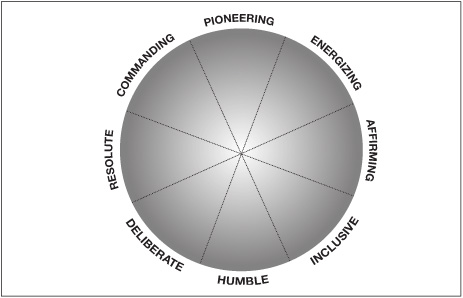
Figure 2.4. My Primary Leadership Dimension
Now that you’ve decided which of the eight dimensions best describes you, you’ll get a chance to learn more about what makes leaders like you tick. In Part 2, the chapter about your primary dimension will describe some of the psychological drivers behind your behavior and help you gain some perspective on your leadership blind spots. You’ll walk away from Part 2 with a better sense of your personal leadership style, and this will help you as you reflect on how to best improve your leadership effectiveness in Part 3.

